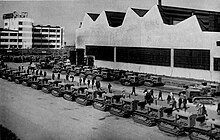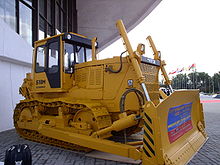Chelyabinsky Traktorny Zavod
| Челябинский тракторный завод - УРАЛТРАК Chelyabinsky Traktorny Zavod - URALTRAK |
|
|---|---|
| legal form | OOO |
| founding | 1933 |
| Seat |
|
| management | Vyacheslav Gennadijewitsch Jumatow ( Russian Вячеслав Геннадьевич Юматов ) |
| Number of employees | 7502 (January 2015) |
| Branch | Mechanical engineering , engine construction , vehicle construction |
| Website | chtz-uraltrac.ru |
The Tscheljabinski Traktorny Sawod ( Russian Челябинский тракторный завод , German translation: Tscheljabinsk Tractor Factory , abbreviation: ЧТЗ , German transcription TschTS, alternatively also TschTZ) is a Russian construction machinery and tank factory in Chelyabinsk .
Since the mid-1990s, the plant has been operating as Tscheljabinski Traktorny Sawod - URALTRAK , and in 2011 Uralwagonzavod took over the majority of the company.
Company history



Before World War II
The Council of Ministers of the USSR passed a resolution in May 1929 to build a tractor plant in the southern Urals. The city of Chelyabinsk was selected because it already had a good energy supply and the coal and steel industries required for it were available. In addition, the Trans-Siberian Railway was an efficient means of transport to deliver the machines to other parts of the Soviet Union. Towards the end of 1929, the Council of Ministers specified its decision and specified that the capacity of the plant should be 40,000 machines per year.
Initially, a cooperation with the US company Caterpillar was planned, but this did not materialize. The plans for the plant were nevertheless drawn up with the help of American experts, among them in particular the architect Albert Kahn , who had previously built large industrial plants in the Soviet Union. The planning phase lasted until June 1930, and the construction process began in August. Plant and machinery did not only come from the USSR, hundreds of German, English, US and French companies also supplied the relevant technology.
The first chain tractor type Stalinez-60 left the factory on 31 May 1933. This tug had high similarity to the American model Caterpillar 60th One day later, production began in the Tscheljabinski Traktorny Sawod imeni Stalina (Eng. Tscheljabinskter Tractor Plant called Stalin, Russian Челябинский тракторный завод имени Сталина ). In 1937, production was switched to the successor Stalinez-65 , and on March 30, 1940, the hundred thousandth chain tractor was built.
Arms production in World War II
Also in 1940 the order was issued to the factory to prepare for the production of tanks. By the time the Soviet Union entered World War II , a small number of KW-1 vehicles had been built. By the end of 1941, the factory was almost completely converted to war production. At the beginning of the year it had manufactured about 87% civil goods, at the end of 1941 it was only 7%. In addition to tanks themselves, tank engines were also manufactured in the Chelyabinsky Traktorny Zavod imeni Stalina.
In the course of restructuring, the factory was given a new name on October 6, 1941. From then on, the plant was called Kirovsky Zavod Narkomtankproma w Gorode Tscheljabinske (German: Kirov plant for tank production in the city of Chelyabinsk, Russian Кировский завод наркомтанкопрома в г. елябинске was retained beyond the end of World War II). In the same year, several large factories from the European part of Russia and other Soviet republics were evacuated to Chelyabinsk because their sites were captured by the German Wehrmacht or massively bombed. These included an engine plant from Kharkiv with 15,000 employees, which was completely relocated to the Urals by rail within a few days.
In November 1941, the production of civil chain tractors was completely stopped in favor of armaments production. Weapons and ammunition were also manufactured. In 1942 more than 27,000 people worked in the plant, but there was still a significant shortage of staff. Women and young people were also employed. In June 1942, work began on converting the facilities so that T-34 tanks could also be manufactured.
Due to the large number of tanks and other armaments produced, the city of Chelyabinsk soon received the name “Tankograd” (German: tank city) in popular parlance. A total of 18,000 tanks were built during the war, plus 48,500 tank engines and 17.7 million pieces of ammunition of all kinds. The plant was awarded the Order of the Red Star in 1944 , as well as the Order of Lenin , once in 1944 and once in 1945 In the same year the Kutuzo Order was awarded.
From the end of the war until today
As early as October 1945 the Council of Ministers of the USSR issued an order to resume planning for a civilian chain tractor. From 1946 the Stalinez-80 was built, which was based on the pre-war construction of the Stalinez-65. Export was also started after the war. From 1949 onwards, the Eastern Bloc was initially supplied, and from the mid-1950s onwards, machines also made their way to Sweden, Austria, India, the Middle East and South America. In 1956, the DET-250 heavy bulldozer was designed, which was one of the first in the world to have a diesel-electric drive . In the same year, the production of the Stalinez-100 began .
On June 20, 1958, the factory was renamed back to Chelyabinsky Traktorny Zavod, and in 1961 serial production of the DET-250 began. In 1963/1964 the chain tractor production was switched to the T-100 model , which was manufactured in various versions up to 1983. In 1969 series production of the successor T-130 began . In 1971 the work was awarded a third time the Order of Lenin, in 1983 the Order of the Red Banner of Labor . In 1988, the super-heavy T-800 bulldozer with 800 hp (588 kW) was presented, which in the same year received an entry in the Guinness Book of Records as the largest bulldozer in the world .
After the collapse of the Soviet Union , the plant was converted into a joint stock company in 1992 . Due to the ensuing economic crisis in the mid-1990s, the company was declared bankrupt before "OOO Tscheljabinski Traktorny Sawod - URALTRAK" was founded. This company, now with limited liability, continued the work. The core competency remained the construction of tracked vehicles of all kinds and the production of tank engines like the W-92 S2 with 1000 HP. In 2011 the arms manufacturer Uralwagonzavod took over the majority of the company's shares.
In 2010 the company had a total turnover of 205.4 million US dollars and the factory premises cover an area of 1,500 hectares.
In the wake of the crisis facing the new parent company since 2015, the plant announced that it would lay off around 6100 of its 7500 employees in February and March 2015. It is unclear whether and to what extent this step was actually implemented.
Product range
Historically, the plant mainly produced tracked tractors and bulldozers, as well as tanks and other armaments. The following list is not complete and is only intended to provide an overview of the most famous vehicles that were built in Chelyabinsk and some are still being built.
Civil products
- Stalinez-60 - civil chain tractor, built from 1933 to 1937.
- Stalinez-65 - civil and military chain tractor, built 1937 to 1941.
- Stalinez-80 - civilian chain tractor, built from 1946 to 1958.
- Stalinez-100 - civil chain tractor, built from 1956 to 1964.
- T-100 - Civil chain tractor or bulldozer, built 1963 to 1983.
- T-130 - Civil chain tractor or bulldozer, built 1969 to 1988.
- T-170 - civil bulldozer / civil chain tractor, manufactured from 1988.
- DET-250 - Civilian diesel-electric bulldozer or chain tractor, built from 1961, later developed into the DET-320 and still available today.
- T-800 (now called T-75.01) - With 820 HP and 106 tons total weight, the largest bulldozer from current production.
Armaments
- KW-1 - heavy tank from before and during World War II
- T-34 - medium tank, built by TschTS from 1942
- T-55 tanks
- W-2 - tank engine, different versions, also manufactured in other plants
In addition, there are various construction machines from today's production such as wheel loaders , pipelayers , chain tractors, special vehicles and attachments. In addition, forged and cast products are manufactured, as well as engines with outputs of around 10 to 1000 hp, including the engine for the Russian T-90 battle tank . According to its own information, the manufacturer is the market leader in the field of construction machinery production in Russia and the CIS countries .
Individual evidence
- ↑ Contact information on the company website (Russian)
- ↑ a b Report on possible job cuts in the Chelyabinsky Traktorny Zavod in February and March 2015 (Russian)
- ↑ a b c d e f g General factory history on the manufacturer's website (Russian)
- ↑ On Kahn's work in the Soviet Union (Russian) ( Memento from January 30, 2010 in the Internet Archive )
- ↑ a b c factory history by year on the manufacturer's website (Russian)
- ↑ Announcement on the takeover by Uralwagonzavod ( Memento from March 10, 2016 in the Internet Archive ) (Russian)
- ↑ a b company profile on their own website (English)
- ↑ Current product range of the plant (English)
Web links
- Official site (Russian and English)
Coordinates: 55 ° 9 ′ N , 61 ° 28 ′ E




